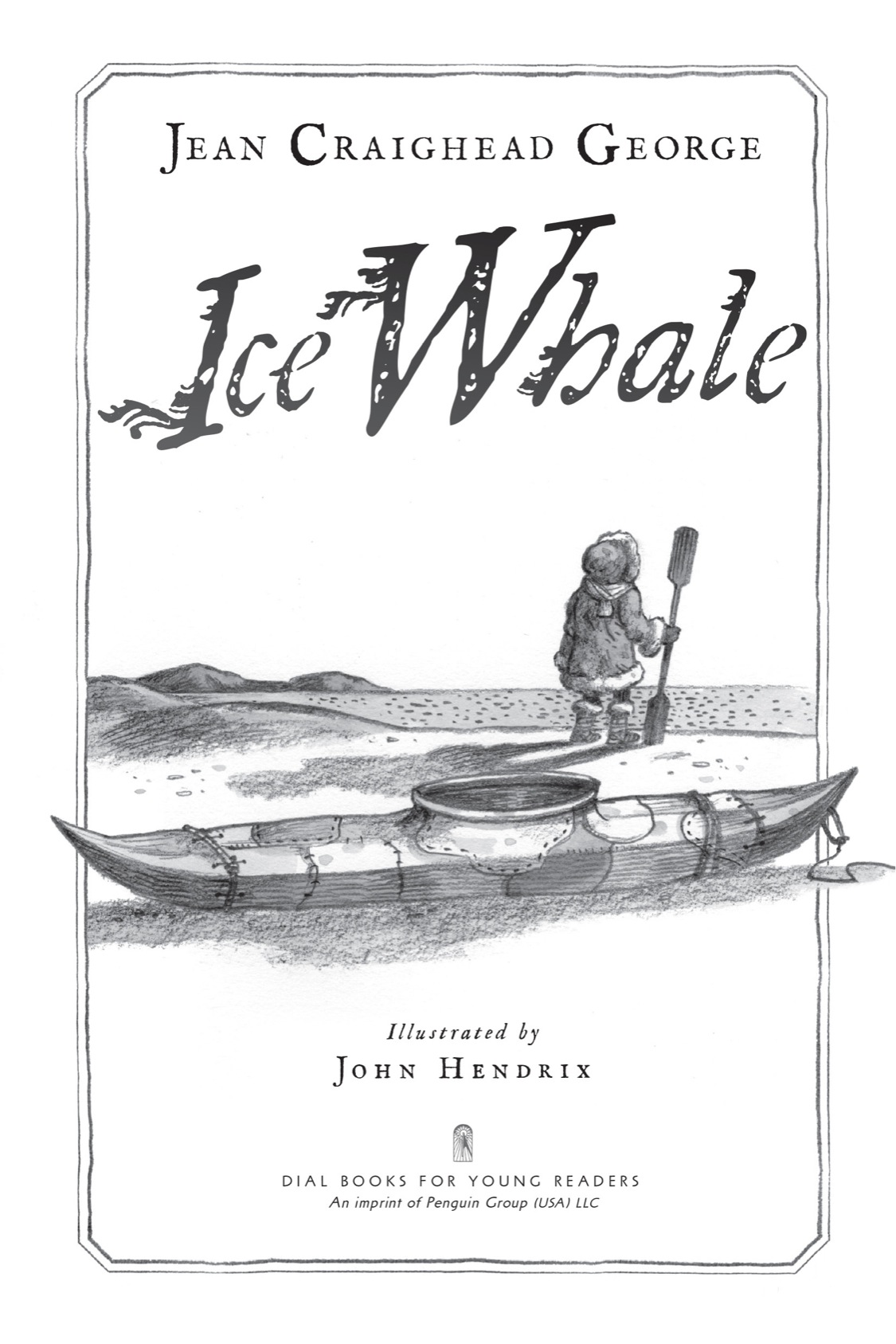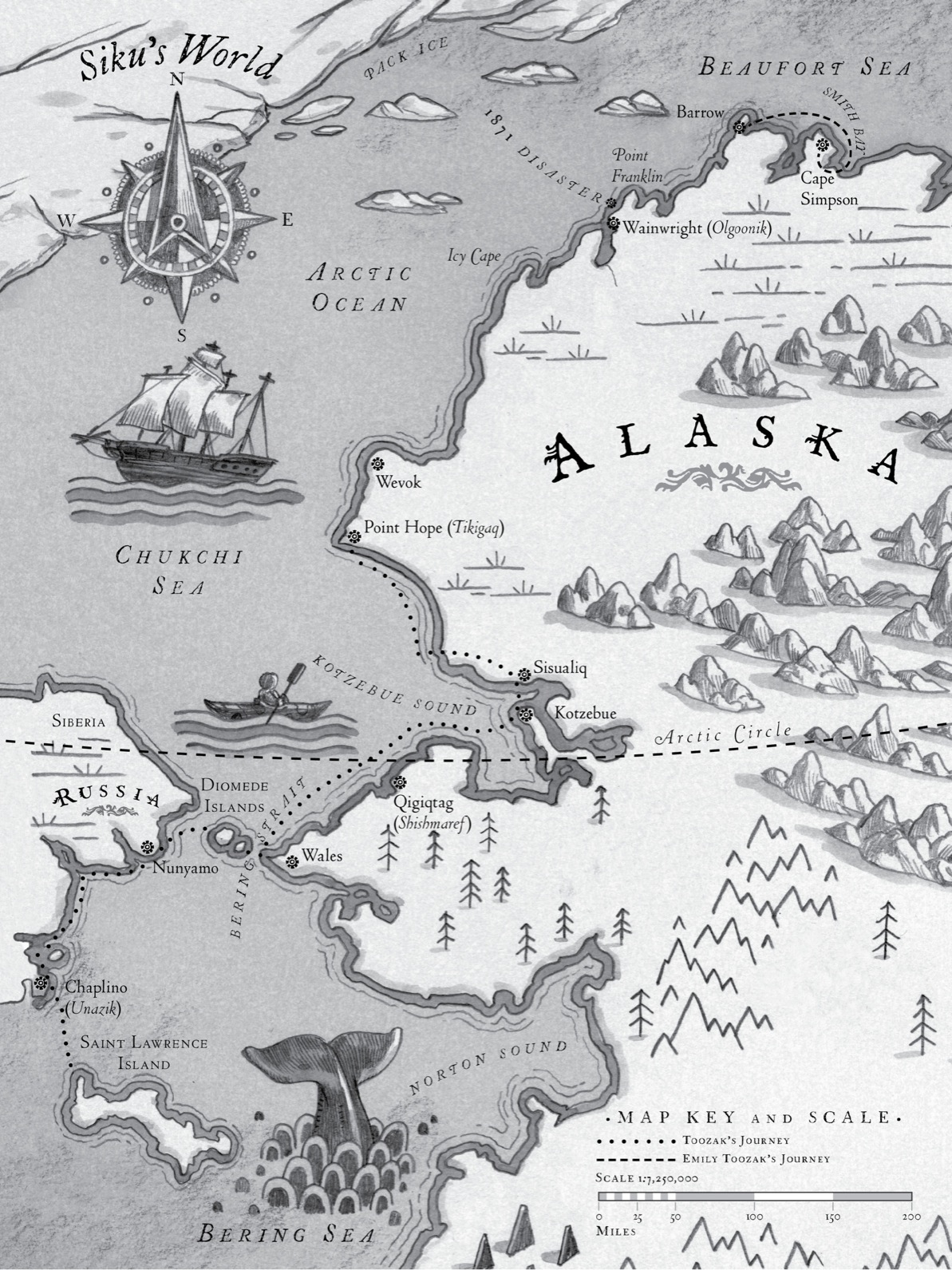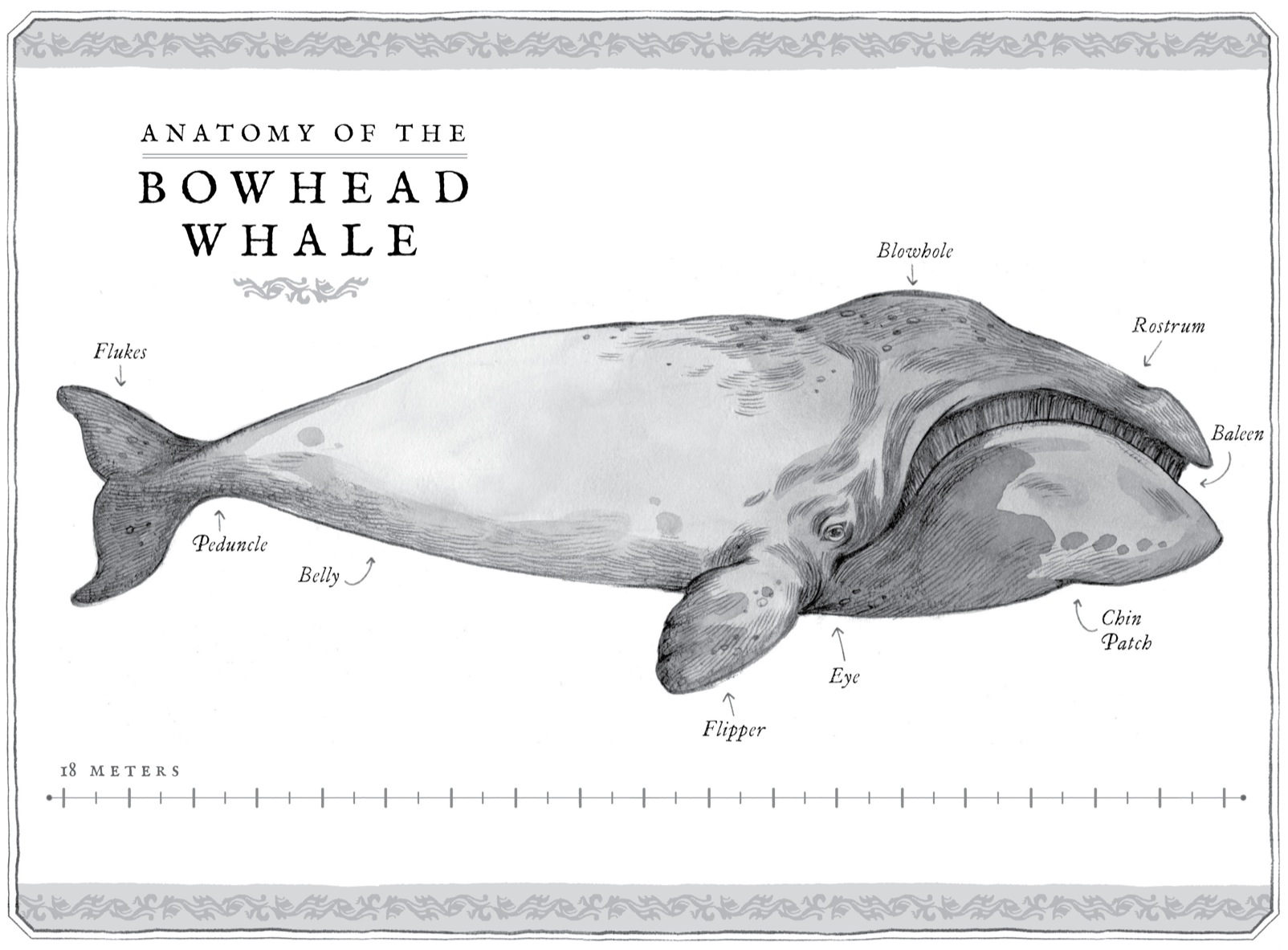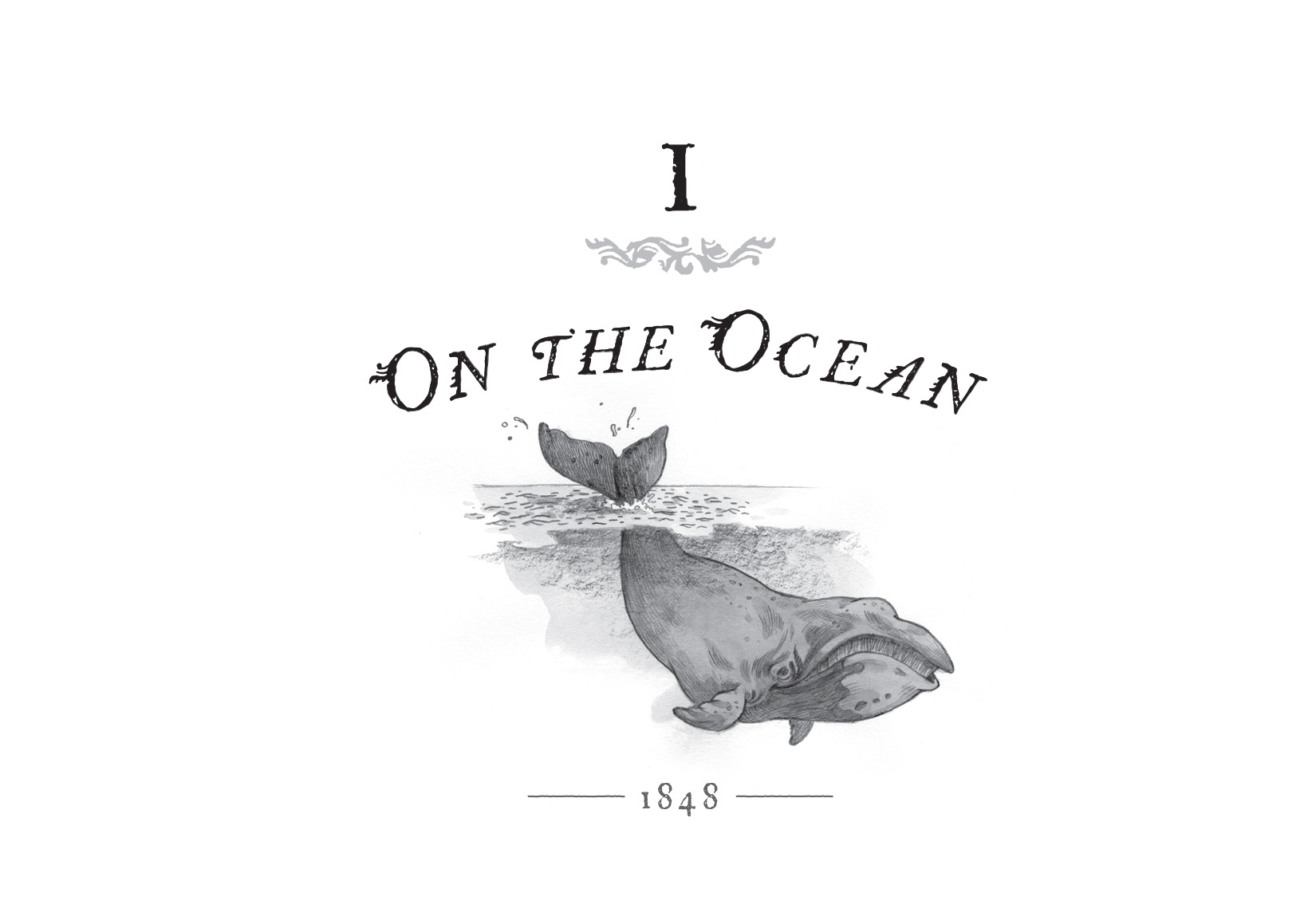Ice Whale
Authors: Jean Craighead George


For Craig

DIAL BOOKS FOR YOUNG READERS
Published by the Penguin Group
Penguin Group (USA) LLCâ 375 Hudson Streetâ New York New York 10014

USA | Canada | UK | Ireland | Australia | New Zealand | India | South Africa | China
A PENGUIN RANDOM HOUSE COMPANY
Copyright © 2014 by Julie Productions, Inc.
Penguin supports copyright. Copyright fuels creativityâ encourages diverse voicesâ promotes free speechâ and creates a vibrant culture. Thank you for buying an authorized edition of this book and for complying with copyright laws by not reproducingâ scanningâ or distributing any part of it in any form without permission. You are supporting writers and allowing Penguin to continue to publish books for every reader.
LIBRARY OF CONGRESS CATALOGING-IN-PUBLICATION DATA
George, Jean Craighead, 1919-2012.
Ice whale / by Jean Craighead George.
pages cm ⢠Summary: In 1848, ten-year-old Toozak, a Yupik Eskimo, sees a whale being born and is told by a shaman that he and his descendants must protect that whale, which Toozak names Siku, as long as it lives. ⢠ISBN 978-1-101-61269-9
1. Yupik EskimosâJuvenile fiction. [1. Yupik EskimosâFiction. 2. EskimosâFiction. 3. Bowhead whaleâFiction. 4. WhalesâFiction. 5. Human-animal relationshipsâFiction. 6. Arctic regionsâFiction.] I. Title. ⢠PZ7.G2933Ice 2014 [Fic]âdc23 2013034090
The publisher does not have any control over and does not assume any responsibility for author or third-party websites or their content.
Version_1
On The Use Of The Symbols For The Whale Sounds
Â
Â
ON THE USE OF THE SYMBOLS FOR THE WHALE SOUNDS
I
n the “In the Ocean” chapters, the author invented symbols that are meant to represent whale sounds. Each whale has its own individual sound, and the author worked out these different symbolic representations for that whale's name. is the symbol for Siku's name.
is the symbol for Siku's name. is the symbol for the old whale, Tiguk's, name.
is the symbol for the old whale, Tiguk's, name.
The sea is anything but a quiet place, and it was a riveting discovery, more than fifty years ago, that whales make sounds or calls underwater that could be recorded. Scientists capture them through underwater recording devices that pick up the sounds as vibrations in the water and convert them to signals that can be heard through speakers. The sounds can also be transcribed as written symbols, somewhat like music where tone or frequency appears as up-and-down strokes arranged on a kind of horizontal grid that indicates time. The result looks a bit like a musical score.
Undoubtedly whale sounds are meant as communication. The author invented symbols for calls that communicated danger, navigation directions, warning, and more. Toothed whales can echolocate, too, enabling them to find food, objects, and each other. We hope this explanation helps as you encounter the symbols in the book.



T
he ocean waves rolled and crestedâ
rolled and
crested
.
Ice floes surfed them. The sun shone cold orange at 10:00 p.m.
The dayâ July 23. The yearâ l848. The placeâ the Bering Strait between Alaska and Russia.
On that historic day, the whaling bark
Superior
â
a chunkyâ blunt-nosed ship with five whaleboats hanging above her deckâ set her sails into the wind. She sped due north and became the first Yankee whaler to sail through the Bering Strait. The tall black rocks of the Diomede Islands loomed in her path. Captain Thomas Roys was trying to steer clear of them.
Suddenly the wind died. The bark's sails sagged and the
Superior
came to a stop. A gull with no wind to ride alighted on the ship's midmast. Walrus barked in the distance. The terrified seamen gathered along her rail. They stared not at the rocksâ but at the formidable Arctic Ocean ahead.
Only a day ago they learned that Captain Roys had paid a hundred dollars to a Russian naval officer for his charts of this ocean. Whale numbers had been decimated by two centuries of whaling in the Atlantic and Pacific. Foreign seamen who had sailed the Arctic Ocean had described it as a dangerous ocean of iceâ fogâ and blizzards. Frightened by the terrifying rumors of sailors freezing to deathâ the crew talked of mutiny.
Their captainâ howeverâ was not looking at that terrible oceanâ but landward. Thirteen Eskimo
umiaqs
â large wood-frame canoes covered with walrus hideâ were paddling toward the
Superior.
In them were three hundred powerful sealskin-clad Eskimo warriors ready to defend their waters and trade routes from intruders. They outnumbered his crew eight to one.
Captain Roys gritted his teeth. There was no wind to carry his ship out of the reach of the
umiaqs
â nor were there guns aboard to defend her. He took out his oneâ old revolver knowing it might not shoot. He wanted it at the ready anyway.
Just then a southwesterly breeze sprang up and carried the
Superior
away from the
umiaqs
and into a misty fog bank. The Eskimos grumbledâa potential trade lost. More wary of the fog than the foreigners, they turned back.
Alone and wrapped in fogâ fear made the crew speak out. They complained aloud about where they wereâin the dreaded Arctic Ocean! The first mate wept.
They talked of mutiny all through the short Alaskan twilight.
At dawn the fog lifted. The sun came out.
Whales were everywhereâ blowing and breachingâ splashing and waving their flukes. Some spy hopped or poked their heads straight upâ thrusting themselves high out of the water to look at the ship. Whale footprintsâ whirlpools on the water made by the fluke of a whale swimming near the surfaceâ pocked the ocean. All hands leaned against the railâ staring. They forgot their plan to mutiny.
“Lord in heavenâ” shouted Tom Boydâ the cabin boy. “Will you look at that!”
Captain Roys saw the whales and thanked his Maker. Leaning against the ship's wheelâ he smiled. He had steered the
Superio
r
into a fortune.
The seamen lowered their whaleboats onto the water and rowed off to hunt the gigantic mammals that were swimming everywhere just beneath the ocean surface.
The heaviest whalers sat in the center of the twenty-eight-foot whaleboats and managed the longest oars. The other men took the seats before and behind them and rowed with shorter oars. This formation kept the eggshell-like boats gliding toward the whales.
The harpoonerâ Hartsonâ a burly manâ stood in the bow. He held his harpoon high. A line was attached to it that would secure the whale to the whaleboat when it was struck. Poisedâ Hartson waited for a whale to come up to the surface to breathe.
No one spoke. They had long ago learned that whales could hear a whisper.
Then a whale surfaced. Hartson thrust the harpoon and struck it. It dove out of sight with the harpoon set in its back. A sea-muffled boom sounded. The seamen waited. Finally the great mammal rose slowly to the surface . . . and floated . . . dead.
“She's a right whaleâ” cheered the harpooner. “She floatsâ that makes her the âright' whale to take.” He laughed and the crew pulled in the line and made it fast to the boat. The whalers now towed the whale to their ship.
When they finally brought the whale alongside the
Superior
â Captain Roys leaned over the railing and stared. The whale was fifty-five feet long with a massive head one-third the length of its body. Its blowhole sat on the highest part of its bowed head. Black in color with smooth skinâ it had blunt flippers and large flukes. Captain Roys smiled. It was not a humpback whaleâ or even a Pacific right whale.
“We have a Greenland right whaleâ” he shouted. “That's the blasted best!”
Greenland right whalesâ or bowhead whalesâ were the prize of commercial whalers. A bowhead had more blubber than any other whale. When this blubber was rendered into whale oilâ it would burn in thousands of lamps in America. The whale's baleenâ or so-called whaleboneâ was used to make umbrella spokesâ corset staysâ and hoop-skirt frames for ladies. The Atlantic right whale had helped make the United States rich and world prominent. Nowâ Captain Roys knewâ the bowhead would do the same.
The whalers hunting the Atlantic Ocean had killed so many right whales that they were now nearly extinct. The hunters had sought new oceans and traveled into the North Pacific. There they found thousands of whales. By 1848â they had hunted the right whales in that ocean to low numbers as well.
And now there was this great discovery in the Arctic Oceanâtens of thousands of the most valuable of whales. Captain Roys's gamble had proved him right. The whalers harpooned another and another. They sang and cheered.
The blubber of these bowheads was at least a foot thickâ the black skin an inch thick. The baleenâlongâ narrowâ fringed plates composed of the same substance as fingernails that hung in the bowhead's mouthâwas much longer than that of any other whale they had hunted before. The sailors looked at the bowhead in wonderment.
The slab of thick blubber was so heavy that it took eight men pulling on the hoist to lift it from the carcass. They sang chanties as they worked. Other whalersâ standing on the cutting stage, a platform attached to the side of the shipâ reached down with large sharp knives on long poles to cut more blubber from the whale. When it was hauled on boardâ it was chopped in small pieces for the tryworksâ cauldrons on the ship that rendered the blubber to oil. When cooled, the whalers poured the oil in barrels.
All day long Captain Roys reaped immense profits for his sponsorsâ the ownersâ his crewâ andâ of courseâ himself. He smiled and stared at the bloody ocean and the blue-green ice floes that rode it.
The whalers worked on, hoisting strip after strip of whale blubber up to the ship's deck.
Superior
's
crew killed many bowhead whales that summer. By the end of Augustâ they had filled their ship and sped south away from the freezing Arcticâ through the Bering Strait to the Pacific Ocean and on to Hawaii.
When the ship arrived in Honoluluâ word traveled from captain to captainâ seamen to seamenâ that there were thousands of bowhead whales in the western Arctic Ocean. Captains outfitted their ships that winter and prepared for the long trip back to the Arctic in the spring.
The slaughter of the great bowhead whale had begun in the western Arctic.